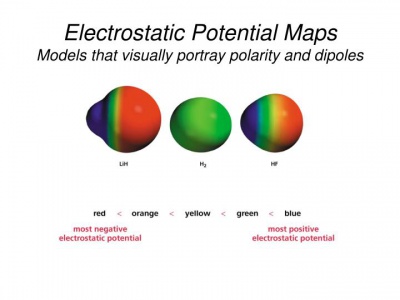Difference between revisions of "WebMO Electrostatic Potential maps"
Jump to navigation
Jump to search
| Line 3: | Line 3: | ||
'''Exercise 5: Electrostatic Potential Maps''' | '''Exercise 5: Electrostatic Potential Maps''' | ||
| − | [https://chem.libretexts.org/Bookshelves/Physical_and_Theoretical_Chemistry_Textbook_Maps/Supplemental_Modules_(Physical_and_Theoretical_Chemistry)/Chemical_Bonding/Fundamentals_of_Chemical_Bonding/Electrostatic_Potential_maps Electrostatic potential maps] show the electron distribution (ie. the composite wavefunction for all electrons) within a molecular frame. for | + | [https://chem.libretexts.org/Bookshelves/Physical_and_Theoretical_Chemistry_Textbook_Maps/Supplemental_Modules_(Physical_and_Theoretical_Chemistry)/Chemical_Bonding/Fundamentals_of_Chemical_Bonding/Electrostatic_Potential_maps Electrostatic potential maps] show the electron distribution (ie. the composite wavefunction for all electrons) within a molecular frame. '''''Did you get that ?''''' <--these pictures are a visual representation of the composite electron wavefunctions. |
| + | |||
| + | The figure below shows an example of the electrostatic potential maps for LiH, H<sub>2</sub>, and HF. | ||
| + | ::*H<sub>2</sub>, the electrons are evenly distributed among the two H-atoms, | ||
| + | ::*LiH, being an ionic compound, the 1s valence electron is transferred to the H-atom showing a clear positive charge (blue - on left) and negative charge (red - on right), | ||
| + | ::*HF, being a covalent bond with the highly electronegative F-atom showing showing a clear positive charge (blue - on left) and negative charge (red - on right). | ||
[[File:EPmaps.jpg|400px|thumb|center||[https://www.slideserve.com/hermione-mendez/electrostatic-potential-maps-models-that-visually-portray-polarity-and-dipoles reference]]] | [[File:EPmaps.jpg|400px|thumb|center||[https://www.slideserve.com/hermione-mendez/electrostatic-potential-maps-models-that-visually-portray-polarity-and-dipoles reference]]] | ||
Using WebMO/Gaussian please complete the following table by optimizing the geometry based the stated level of theory and basis set: | Using WebMO/Gaussian please complete the following table by optimizing the geometry based the stated level of theory and basis set: | ||
Revision as of 14:17, 23 April 2020
(4/23/20, bes)
Exercise 5: Electrostatic Potential Maps
Electrostatic potential maps show the electron distribution (ie. the composite wavefunction for all electrons) within a molecular frame. Did you get that ? <--these pictures are a visual representation of the composite electron wavefunctions.
The figure below shows an example of the electrostatic potential maps for LiH, H2, and HF.
- H2, the electrons are evenly distributed among the two H-atoms,
- LiH, being an ionic compound, the 1s valence electron is transferred to the H-atom showing a clear positive charge (blue - on left) and negative charge (red - on right),
- HF, being a covalent bond with the highly electronegative F-atom showing showing a clear positive charge (blue - on left) and negative charge (red - on right).
Using WebMO/Gaussian please complete the following table by optimizing the geometry based the stated level of theory and basis set:
